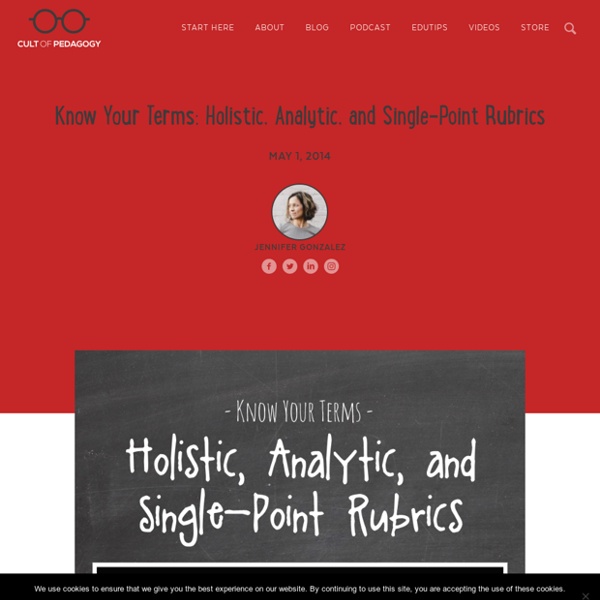



https://www.cultofpedagogy.com/holistic-analytic-single-point-rubrics/
The Single Point Rubric Recently, I read “Know Your Terms: Holistic, Analytic, and Single-Point Rubrics” by Jennifer Gonzalez, of Cult of Pedagogy. It introduced me to the Single-Point Rubric and this tool has transformed my teaching. I made some hacks to this rubric to better meet my needs and, ultimately, allow me to provide more thorough and meaningful feedback to my students. I’ve had issues with the traditional four-point rubric because, despite their attempt to be objective, they end up limiting a teacher’s ability to provide students with personalized feedback. The Single-Point Rubric simply identifies the objectives of an assignment but allows the teacher to assess a limitless spectrum of possible responses student can offer. In Maja Wilson’s Rethinking Rubrics she points out that holistic and analytic rubrics drive a teacher to think only about the rubric while using it to assess student work.
Yes, You Can Teach and Assess Creativity! A recent blog by Grant Wiggins affirmed what I have long believed about creativity: it is a 21st-century skill we can teach and assess. Creativity fosters deeper learning, builds confidence and creates a student ready for college and career. However, many teachers don't know how to implement the teaching and assessment of creativity in their classrooms. While we may have the tools to teach and assess content, creativity is another matter, especially if we want to be intentional about teaching it as a 21st-century skill.
Tame the Beast: Tips for Designing and Using Rubrics Rubrics are a beast. Grrrrrrr! They are time-consuming to construct, challenging to write and sometimes hard to use effectively. They are everywhere. 5 Types of Rubrics to Use in Your Art Classes - The Art of Ed Most art teachers use rubrics to assess students’ work. Rubrics are a great way to make sure students understand the expectations of the assignment. Because all the criteria are clearly defined, they make grading 100 still life artworks much easier. I use the term “easier” loosely here; we all know grading 100 artworks is never easy!
February PD Day Slides One account. All of Google. Sign in to continue to Slides Find my account Rubrics 101 A rubric is commonly defined as a tool that articulates the expectations for an assignment by listing criteria, and for each criteria, describing levels of quality (Andrade, 2000; Arter & Chappuis, 2007; Stiggins, 2001). Rubrics contain three essential features: criteria students are to attend to in completing the assignment, markers of quality (typically rating scales), and scoring. Criteria are used in determining the level at which student work meets expectations. Markers of quality give students a clear idea about what must be done to demonstrate a certain level of mastery, understanding, proficiency (i.e., "excellent" does xyz, "fair" does only xy or yz, "poor" does only x or y or z).
Why We Need to Move Away from SMART Goals and Towards New Forms of Classroom Assessment Every new school year breathes new life into my professional career. After a summer of relaxation and self-directed professional development (which is the most important type of PD), I’m ready to return to my classroom to help students discover and refine new skills. While that may be the case again this year, I also find myself becoming increasingly unsettled as my career progresses. My uneasiness is a culmination of years of reflection on my classroom mission. My district has taken on new initiatives the past few years (as all districts do) to solve the well-documented, disconnected nature between high school graduates and workplace preparedness.
Rubricas de evaluación en el aula y CoRubrics LinkedIn emplea cookies para mejorar la funcionalidad y el rendimiento de nuestro sitio web, así como para ofrecer publicidad relevante. Si continúas navegando por ese sitio web, aceptas el uso de cookies. Consulta nuestras Condiciones de uso y nuestra Política de privacidad para más información. LinkedIn emplea cookies para mejorar la funcionalidad y el rendimiento de nuestro sitio web, así como para ofrecer publicidad relevante. Curricoli per competenze Modelli di curricoli per competenze chiave articolati anno per anno Di seguito si propongono i modelli di curricoli per competenze chiave, basati sulle Indicazioni 2012, articolati anno per anno. Non cambiano, ovviamente, le competenze chiave, né quelle culturali specifiche, che restano sempre uguali; vengono sgranate nel tempo le abilità e le conoscenze. Si precisa, però, che questi curricoli rappresentano meri esempi di metodo e non costituiscono in alcun modo indicazioni d’obbligo. Le scuole potranno utilizzarli come ispirazione per i propri, apportando tutte le modifiche che riterranno opportune, specialmente nella scansione e nel contenuto delle micro-abilità e delle conoscenze.
Franca Da Re La certificazione delle competenze nel primo ciclo di istruzione. La C.M. n. 3 del 13 febbraio 2015, mette fine ad un vuoto nelle pratiche valutative della scuola italiana, che si protraeva dal 2007, primo anno nel quale è stata introdotta obbligatoriamente la certificazione delle competenze al termine della scuola secondaria di primo grado, estesa, negli anni successivi, anche alla scuola primaria, con l’emanazione della Legge 169/08 e del DPR 122/09. Il modello nazionale introdotto in forma sperimentale dalla C.M. 28 del 2007, mancando dei criteri di valutazione delle competenze stesse, non si discostava molto da una pagella di profitto.
Cómo construir Rúbricas o Matrices de Valoración ¿QUÉ SON LAS RÚBRICAS? Una Matriz de Valoración (Rúbrica – Rubric, en inglés [1]) es un instrumento que facilita la evaluación del desempeño de los estudiantes, especialmente, en temas complejos, imprecisos o subjetivos. Este instrumento podría describirse como una matriz de criterios específicos que permiten asignar u otorgar un valor (valorar), basándose en una escala de niveles de desempeño y un listado de aspectos que evidencian el aprendizaje, los conocimientos y/o las competencias alcanzadas por el estudiante en un tema particular. Le invitamos a conocer el esquema básico de una Rubrica y algunos ejemplos de Rúbricas. Esquema de una Rúbrica De acuerdo con la definición antes expuesta, una Matriz de Valoración o Rúbrica sirve para establecer o consultar cómo va el proceso de aprendizaje del estudiante.